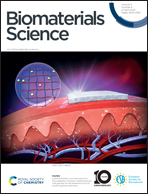An aminopeptidase N-based color-convertible fluorescent nano-probe for cancer diagnosis†
Abstract
Specific cancer diagnosis at an early stage plays a significant role in preventing cancer metastasis and reducing cancer mortality. Thus, exploring specific and sensitive fluorescent probes to realize early cancer diagnosis is an urgent need in clinic. Aminopeptidase N (APN/CD13), overexpressed in numerous malignant tumors, is an important tumor biomarker associated with cancer progression, invasion, and metastasis. In this study, a novel fluorescent molecule APN–SUB, capable of monitoring APN in real time, is encapsulated in a pH-responsive block copolymer (termed APN–SUB nanoprobe) for cancer diagnosis. APN–SUB contains a fluorophore center and a trigger moiety (leucine group), which is covalently conjugated on the fluorophore with an amide bond. The hydrolysis of the amide bond in APN–SUB activated by APN leads to a red shift of maximum fluorescence emission wavelength from 495 nm to 600 nm, realizing dual-color transformation from green to red. Moreover, the APN–SUB nanoprobe with pH-responsiveness is prepared to improve the accumulation and the release rate in the tumor region. It is worth noting that the APN–SUB nanoprobe exhibits good performance for APN imaging, namely, superior limit of detection (0.14 nU mL−1), excellent selectivity and strong photostability. More importantly, the APN–SUB nanoprobe can be successfully employed as a color-convertible fluorescent probe for cancer diagnosis by tracking the activity of APN with high specificity and sensitivity in vivo, demonstrating its potential value for cancer diagnosis.



 Please wait while we load your content...
Please wait while we load your content...